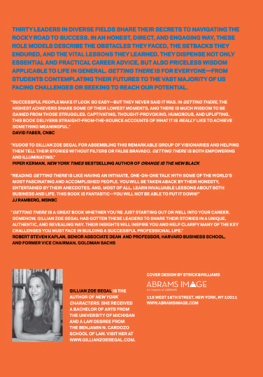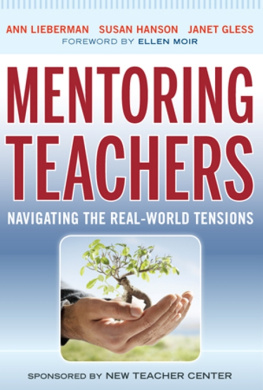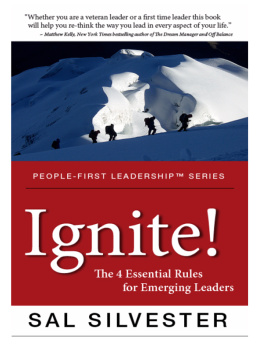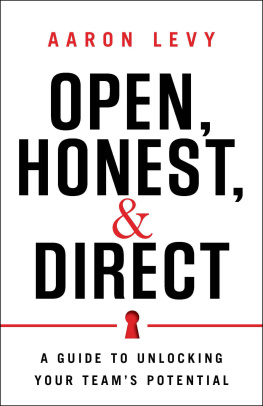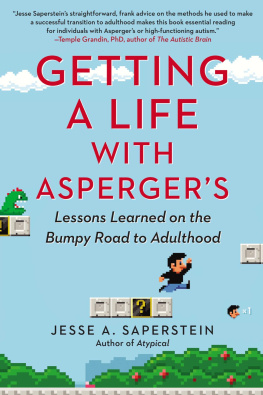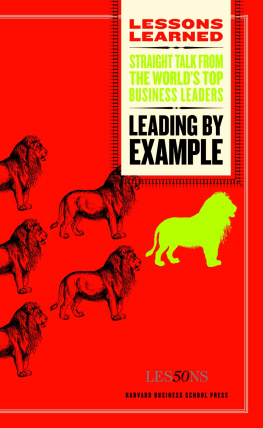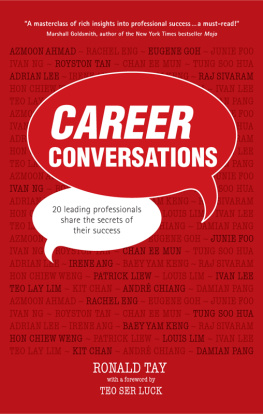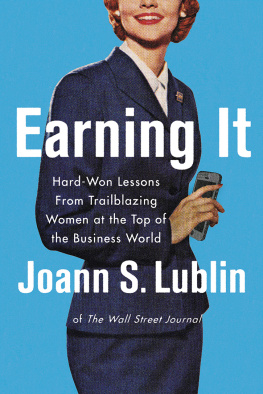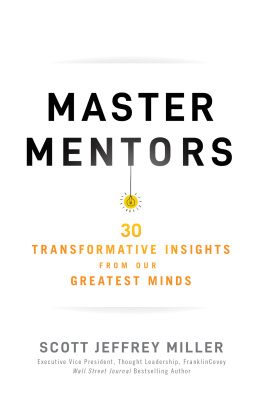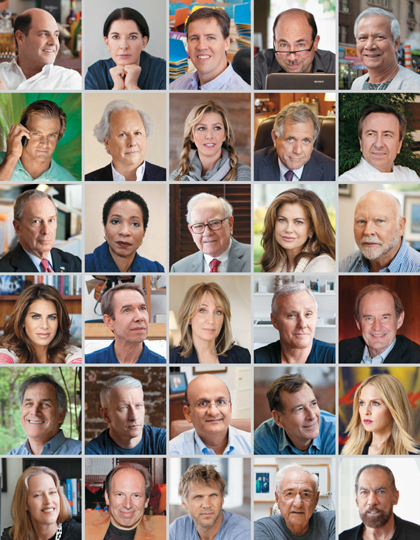

FOR SAGE
TABLE OF CONTENTS
INVESTOR
MAD MEN CREATOR
BLOOMBERG L.P. FOUNDER/FORMER NEW YORK CITY MAYOR
SPANX INVENTOR
JOURNALIST
LAWYER
JOHN PAUL MITCHELL SYSTEMS/PATRN SPIRITS COMPANY CO-FOUNDER
SCIENTIST
CBS PRESIDENT AND CEO
FITNESS EXPERT
BREWER AND FOUNDER OF THE BOSTON BEER COMPANY
ENTREPRENEUR/HOTELIER/REAL ESTATE DEVELOPER
VANITY FAIR EDITOR
MODEL/ENTREPRENEUR/DESIGNER
HARVARD BUSINESS SCHOOL DEAN
ARTIST
NANTUCKET NECTARS CO-FOUNDER
TEACH FOR AMERICA FOUNDER
BIG WAVE SURFER
NOBEL PEACE PRIZE RECIPIENT
STYLIST/FASHION DESIGNER
DIARY OF A WIMPY KID AUTHOR
ARTIST
STONYFIELD FARM CHAIRMAN AND CO-FOUNDER
CRAIGSLIST FOUNDER
CO-CHAIRMAN, 20TH CENTURY FOX
CARE USA PRESIDENT AND CEO
COMPOSER
CHEF
ARCHITECT
INTRODUCTION
I used to imagine that highly successful people were practically born that waythat they either had a meteoric rise to the top or, at the very least, enjoyed a smooth, steady climb along some primrose path. Although I grew to realize that this is not true, I was still continually taken aback by the singular stories the subjects of this book told methe obstacles they overcame, the setbacks they endured, and the defining moments (sometimes even in childhood) that infused them with the tenacity and strength they needed to prevail.
I thought about how this book would help everyone from students just starting to contemplate their futures to those well into a successful careerand especially my daughter, Sage. I couldnt wait to incorporate the lessons my subjects imparted into my parenting, and hoped that one day Sage would be happy to have this compendium of wisdom at her fingertipsa series of unguarded, intimate pep talks from some of the worlds most influential and inspirational figures.
It wasnt until I was halfway through the project, however, that I understood what was truly motivating me. They say that people teach what they need to learn. While I am genuinely excited to inspire my daughter and others, I believe I was drawn to create this book because I desired guidance and inspiration from these luminaries.
My own career trajectory began with a plan to follow an explicit, linear path that culminated at a distinct destinationbut as I entered my early twenties, the path became quite circuitous.
Like most parents, mine wanted my three brothers and me to grow up to be successful. And in our household, success was pretty much defined by two things: wealth and being your own boss. Since a career was viewed as a means to financial autonomy, we were discouraged from pursuing things we enjoyed but that were unlikely to lead to a large income. Instead, we were urged to go to law school (its good training for anything), then immediately, embark upon a financially motivated entrepreneurial venture. I reasoned that, while it was certainly quite specific, this wasnt a bad plan. After all, who wouldnt want to be rich and independent?
During law school, I contemplated different ways to make my fortune but nothing either drew me in or seemed like the right fit. As graduation neared, I became increasingly anxious about what I would do afterward. I started to wonder if I was going about planning my future the right way, and I spent a lot of time trying to figure out how others had discovered their callings and forged their paths.
A real turning point occurred when, shortly after taking the bar exam, I read a commencement address given by the cartoonist Cathy Guisewite at my alma mater, the University of Michigan. Cathy spoke about the moment she realized she wanted to write for a living and suggested that, when deciding what to do with the rest of their lives, the graduates remember what they love: Take the classes, the friends, and the family that have inspired the most in you. Save them in your permanent memory and make a backup disk. When you remember what you love, you will remember who you are. If you remember who you are, you can do anything.
Cathys words resonated with me. Following her advice, I thought back over my four years at Michigan. I had been most energized by the photography course I took the last semester of my senior year. Drawn immediately to portraiture, I found joy in connecting with different types of people and would spend hours in the darkroom studying and developing prints. I decided to pursue this interest and enrolled in a one-year program at the International Center of Photography (ICP). Soon after that, I hatched the idea for my first book, New York Characters.
The theory behind New York Characters is that what makes New York such an amazing city is its people. Among the millions of New Yorkers, there are some who become famous in their own subcultures and give the Big Apple its flavor. I began photographing and interviewing them. My subjects included neighborhood fixtures, prominent celebrities, and the truly eccentric.
Working on New York Characters was a dream come true. Every day felt like an adventure as I discovered different pockets of my city and got to know a broad cross section of its population. However, getting a book published when I had no track record as a photographer or writer didnt prove to be an easy task.
Beginning with the traditional route, I put together a book proposal and shopped around for an agent. No one wanted to represent me. When I approached teachers at ICP for advice, they told me that I should start by interning for an established photographer, then work on my own rsum, then try to get a book published. Ignoring this advice, I decided to take the bull by the horns and represent myself. I parked myself in a bookstore, combed through the photography and New York sections, and made a list of the publishers that might be interested in a book like mine. I even read the acknowledgment sections of certain books so I knew the specific person to target at each company. To make a long story short, the first publisher I contacted, W. W. Norton & Company, loved my work and ended up publishing New York Characters.
But even with a contract from a well-known publisher, I had a difficult time getting subjects to participate in my book. My rule became that until I received a definite no from a subject I would continue to politely contact him or her until my deadline arrived. (Who am I kidding? Even when I did get a definite no, I wasnt deterred. I would wait a bit then look for another angle from which to approach.) I called Spike Lees office at least thirty times, befriended one of his assistants over the phone, and had him go to bat for me. If I hadnt been so passionate about
Next page
